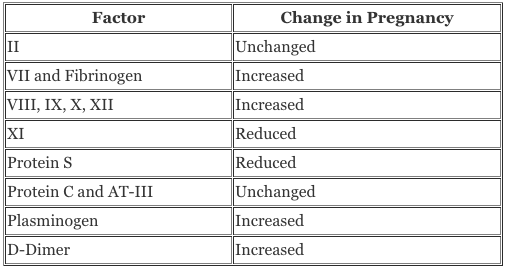Copy link
Coagulation changes in pregnancy
Last updated: 03/02/2015
Pregnancy is a state of hypercoagulation, which is likely an adaptive mechanism to reduce the risk of hemorrhage during and after the delivery process. Unfortunately as a result of the hypercoagulable state, thromboembolism is one of the leading causes of death associated with pregnancy, particularly in developed nations, with clinically significant venous thromboembolism occurring in 1 of every 1000 to 2000 pregnancies. The hypercoagulability of blood during pregnancy has been confirmed with Thromboelastography (TEG) and is thought mainly due to the increased production of factor VII and fibrinogen. Although many of the coagulation factors are increased during pregnancy, none are quite to the extent of factor VII and fibrinogen.
The risk of developing a venous thromboembolism increases about 100-fold when a parturient is admitted to a hospital and also seems to be worse during the third trimester. This is thought to be due to changing hormonal levels, in particular increased estrogen as pregnancy progresses. It is important to note that the classic Virchow’s Triad favors thrombus formation in pregnancy with increased venous stasis, increased coagulability factors, and increased endothelial damage. Risk of venous thromboembolism in pregnancy increases with the following additional risk factors: obesity, smoking, multiple gestations, advanced maternal age, increased parity, cesarean section, as well as the presence of a concomitant thrombophila. Unfractionated heparin and low molecular weight heparin are the modalities of choice for anticoagulation during pregnancy.
There is some evidence to suggest that the body creates a level of homeostasis by also increasing fibrinolysis to a certain extent. During pregnancy, we see increases in plasma activity of plasminogen alpha2-antiplasmin and elevated concentrations of D-dimer, which suggests increased fibrinolytic activity and the restriction of fibrin formation. This would explain that despite all the factors favoring a hypercoagulable state in pregnancy, venous thromboembolism remains a relatively rare event.

References
- Alyshah Abdul Sultan, Joe West, Laila J Tata, Kate M Fleming, Catherine Nelson-Piercy, Matthew J Grainge Risk of first venous thromboembolism in pregnant women in hospital: population based cohort study from England. BMJ: 2013, 347;f6099 PubMed Link
- Emily M Armstrong, Jessica M Bellone, Lori B Hornsby, Sarah Treadway, Haley M Phillippe Pregnancy-Related Venous Thromboembolism. J Pharm Pract: 2014, 27(3);243-252 PubMed Link
- Ekaterina H Uchikova, Ilija I Ledjev Changes in haemostasis during normal pregnancy. Eur. J. Obstet. Gynecol. Reprod. Biol.: 2005, 119(2);185-8 PubMed Link
Other References
- Keys to the Cart: September 18, 2017; A 5-minute video review of ABA Keywords Link
Copyright Information

This work is licensed under a Creative Commons Attribution-NonCommercial-NoDerivatives 4.0 International License.